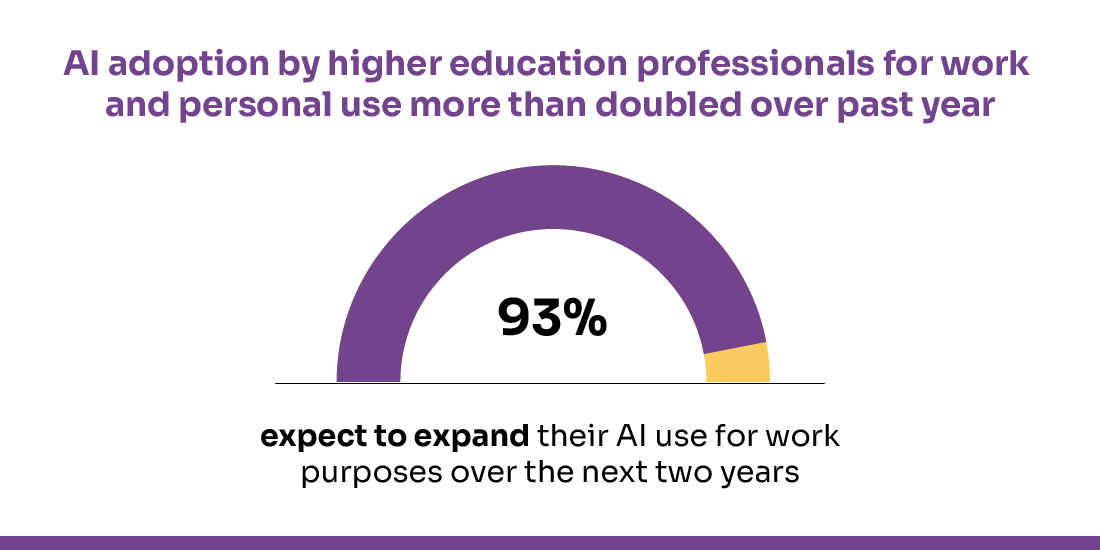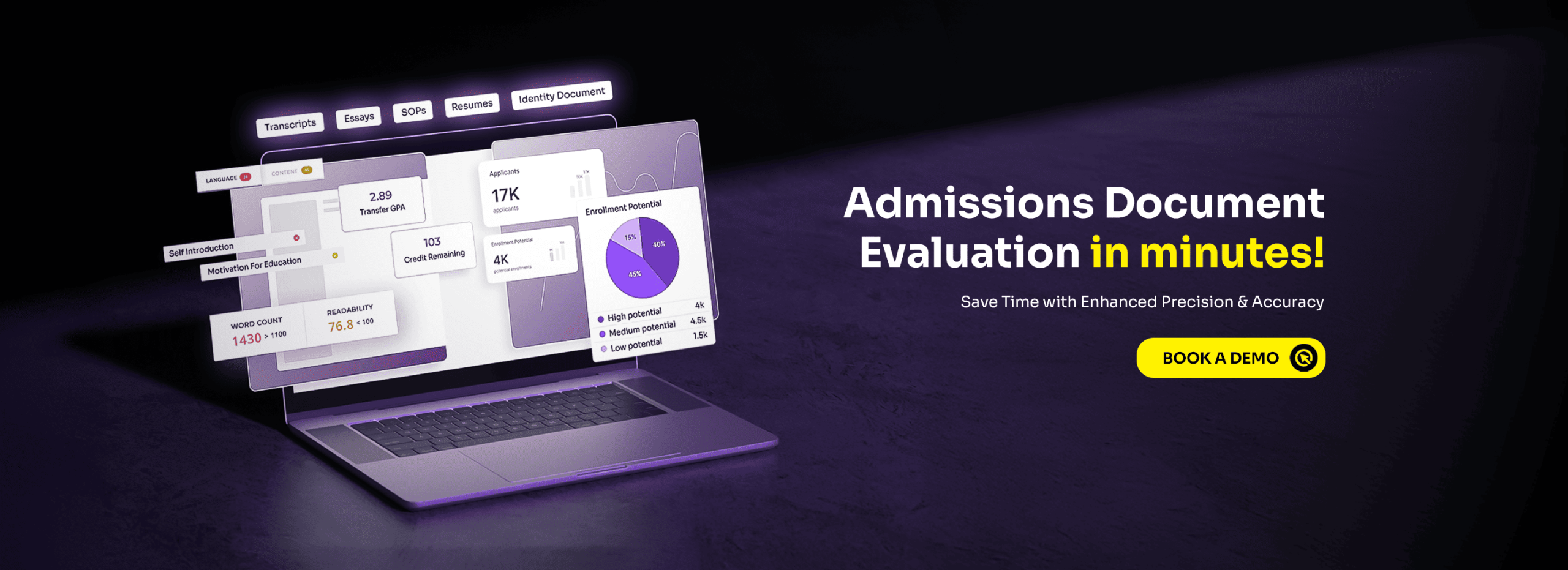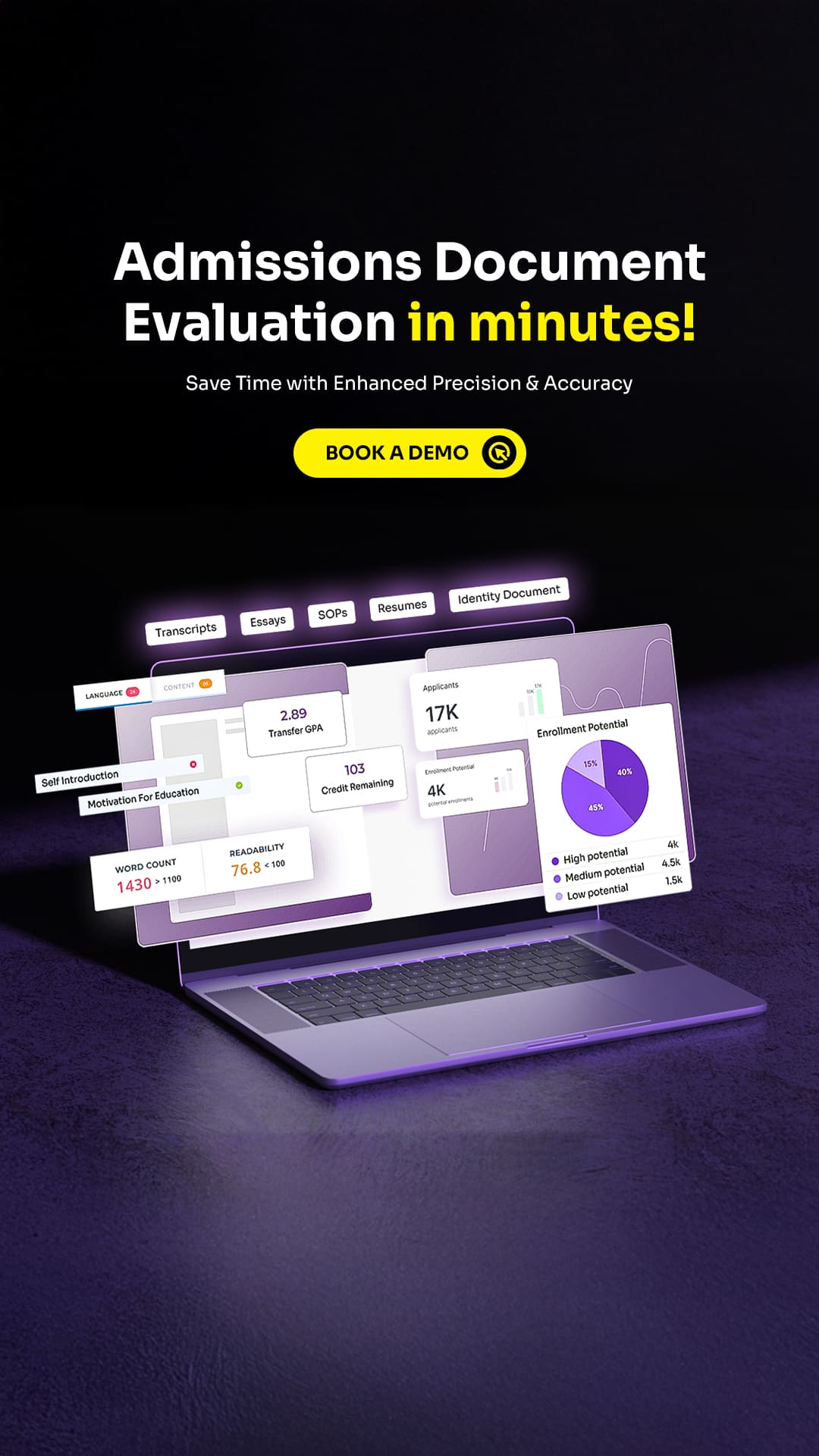Table Of Contents
- 1Introduction
- 2Importance of Strategic Planning in Higher Education
- 3Core Components of an Effective Strategic Plan in Higher Education
- 4A Stepwise Approach to Strategic Planning in Higher Education
- 5How Other Plans Influence Strategic Planning in Higher Education
- 6Key Challenges in Implementing Strategic Plans in Higher Education
- 7Conclusion
Introduction
Strategic planning is crucial for higher education institutions to remain competitive and deliver quality education in a rapidly changing environment. Today, planning extends beyond traditional academic and operational goals to include technology, innovation, and student-focused strategies. With nearly two-thirds of universities already implementing or developing guidance on AI use, institutions must integrate advanced tools to enhance decision-making and outcomes. This blog serves as a practical guide to strategic planning in higher education, showing leaders how to set clear objectives, make data-driven decisions, and measure success for sustainable growth and long-term impact.
Importance of Strategic Planning in Higher Education
Strategic planning plays a vital role in helping universities align their mission with achievable goals. It provides a clear roadmap for effective operations, ensuring that every department, program, and initiative contributes to the institution’s overall vision and long-term success. Here’s how strategic planning supports growth and excellence in higher education:
Mission-Aligned Decision-Making
Strategic planning ensures that an institution’s mission and values guide every decision. When all departments and programs align their objectives with the broader mission, the university operates as a cohesive, purpose-driven organization. This alignment not only strengthens institutional focus but also supports student success and retention. For example, in the U.S., top universities like MIT and the University of Chicago maintain nearly 99% first-year retention rates, demonstrating that institutions with clear missions and high standards effectively retain students.
Efficient Budget Management
Universities often face financial constraints, making it essential to allocate resources wisely. Strategic planning helps prioritize spending on critical areas such as student services, research, and infrastructure. This ensures funds are used efficiently, maximizes impact, and reduces unnecessary expenses, supporting long-term institutional growth.
Faculty Development and Support
A strong strategic plan focuses on faculty growth by connecting professional development, training, and research opportunities to the institution’s goals. By providing support for career advancement and skill enhancement, universities enable faculty to perform at their best, contributing to both individual success and overall institutional excellence.
Improved Student Success
Strategic planning helps institutions create programs, support services, and learning environments that enhance student outcomes. By identifying student needs, setting measurable goals, and aligning resources effectively, universities can improve academic performance, engagement, and overall satisfaction. Institutions that plan strategically are better equipped to implement initiatives that support retention, graduation rates, and career readiness, ensuring students succeed both during and after their studies.
Adaptability to Change
Higher education is always changing because of new technology, policies, and student needs. Strategic planning helps universities stay flexible and adjust to these changes while keeping long-term goals in mind. For instance, a 2025 provost survey found that nearly 90% of faculty are discussing AI, and 77% of senior leaders see it as important, showing that effective strategic planning must include emerging technologies to remain relevant and forward-thinking. Tools like the Edmo Plugin help institutions use predictive analytics to forecast trends, understand student needs, and make better data-driven decisions for the future.
Sustainable Growth and Future Readiness
A well-designed strategic plan helps universities address current challenges while preparing for the future. It ensures institutions remain resilient, relevant, and able to meet evolving educational needs. For example, the University of Oxford’s Strategic Plan 2018–2023 focuses on long-term sustainability, setting goals in education, research, culture, and global outreach to secure growth and continued excellence.
Core Components of an Effective Strategic Plan in Higher Education
A well-crafted strategic plan acts as a roadmap that guides a university’s decisions, resource allocation, and long-term vision. While the structure may vary based on institutional culture and priorities, an effective higher education strategic plan typically includes the following key components:
Clear Mission and Vision
Every strategic plan starts with a clear mission and vision. The mission explains what the university stands for and what it aims to achieve, while the vision shows where it wants to go in the future. A clear mission and vision help all departments work toward common goals. For example, MIT’s strategic planning follows its mission to advance knowledge and educate students in science and technology. Its “MIT 2030” initiative provides a flexible plan that helps the university grow and adapt to changes in higher education.
Strategic Priorities
Strategic priorities identify the main areas that will drive institutional success. These may include goals like enhancing academic quality, improving campus infrastructure, expanding research output, or fostering community engagement. Setting clear priorities helps the institution channel its efforts and resources toward areas that create the greatest long-term impact.
Stakeholder Engagement
An effective strategic plan actively involves all key stakeholders, including faculty, staff, students, alumni, and the local community. Engaging stakeholders ensures the plan reflects diverse perspectives and addresses real institutional needs. It also builds trust, fosters collaboration, and creates a shared responsibility for achieving goals. Research indicates that 67% of institutions holding regular stakeholder meetings report better recruitment outcomes, highlighting the value of inclusive planning in higher education.
Data-Driven Goals
Successful strategic planning depends on using accurate data to set realistic and measurable goals. By looking at information such as enrollment trends, budgets, and student performance, institutions can make better decisions and monitor their progress. According to a Forbes survey, 90% of higher education leaders say data-driven decision-making is essential for success, showing how important evidence-based planning has become today.
Strategic Resource Allocation
Effective resource allocation is key to putting a strategic plan into action. By aligning financial, human, and technological resources with institutional priorities, universities can avoid overspending, reduce inefficiencies, and ensure investments directly support goals like student success, research, and digital innovation.
SWOT Analysis (Strengths, Weaknesses, Opportunities, Threats)
A comprehensive SWOT analysis helps institutions understand both internal capabilities and external challenges. By identifying what’s working well and where improvements are needed, universities can develop strategies that leverage strengths, mitigate risks, and seize growth opportunities in a competitive higher education environment.
Accountability Framework
Accountability ensures that the strategic plan moves beyond paper to action. Assigning clear responsibilities, timelines, and performance indicators allows progress to be tracked effectively. Regular reviews, transparent communication, and leadership oversight create a culture of accountability and continuous improvement.
Continuous Monitoring and Evaluation
Strategic planning is an ongoing process, not a one-time task. Regular monitoring helps universities track progress, measure results, and adjust strategies as needed. By evaluating performance continuously, institutions can identify what’s working and what needs improvement, keeping the plan relevant and effective. Universities that use dashboards to track key performance indicators have reported a 30% reduction in misaligned objectives, showing the value of consistent evaluation.
A Stepwise Approach to Strategic Planning in Higher Education
A successful strategic plan in higher education requires a structured, sequential approach to ensure alignment, clarity, and effectiveness. The following steps outline a comprehensive process:
Define the Vision and Mission
Begin by establishing the institution’s vision—the aspirational state it aims to achieve—and a mission statement that articulates its core purpose and primary educational objectives.
- A clear vision and mission provide the foundation for all strategic planning and guide subsequent decisions.
- In higher education, revisiting these statements ensures they reflect the institution’s evolving identity, values, and commitment to teaching, research, and community engagement.
Conduct a Comprehensive Situational Analysis
Perform an in-depth situational analysis to evaluate internal capabilities and external factors.
- Use tools like SWOT (Strengths, Weaknesses, Opportunities, Threats) to understand the institution’s current state.
- Consider factors such as faculty expertise, academic resources, industry trends, student demographics, and economic changes to identify areas for improvement and potential competitive advantages.
Establish Strategic Objectives
Translate insights from the situational analysis into clear, actionable objectives.
- Ensure objectives are SMART: Specific, Measurable, Achievable, Relevant, and Time-bound.
- Frameworks like the Balanced Scorecard help consider multiple perspectives, including student success, faculty development, operational efficiency, and community impact.
Develop Targeted Strategies
Outline strategies that detail how the institution will achieve its objectives.
- Prioritize initiatives, allocate resources, and define the actions required to meet goals.
- Examples in higher education include improving curriculum offerings, adopting new technologies, expanding research programs, and enhancing student support services.
Create Detailed Action Plans
Convert strategies into executable action plans.
- Break down each strategy into specific steps, assign responsibilities, define resources, and set timelines.
- Action plans may include implementing new academic programs, conducting faculty training, or establishing strategic partnerships with industry and other educational institutions.
Define and Monitor Success Metrics
Set clear metrics to track progress and evaluate outcomes.
- Key Performance Indicators (KPIs) such as student retention, graduation rates, research output, and employment placement rates provide measurable benchmarks.
- Tools like the Balanced Scorecard help align metrics with strategic objectives and facilitate ongoing evaluation and improvement.
Finalize, Communicate, and Implement the Plan
Document the strategic plan, summarizing the mission, vision, objectives, strategies, and success metrics.
- Share the plan with faculty, staff, students, and other stakeholders to gather feedback, identify gaps, and enhance buy-in.
- A collaborative approach ensures the plan is realistic, actionable, and supported by the entire institution for effective implementation.
How Other Plans Influence Strategic Planning in Higher Education
In higher education, strategic planning does not happen in isolation—it is shaped by various institutional plans that work together to guide the institution’s growth and success.
Academic Plans: Aligning Curriculum with Strategic Goals
Academic planning plays a key role in strategic planning by ensuring that curricula and teaching methods support the university’s mission and long-term objectives. For example, Indiana’s public universities are revising over 400 academic programs to better reflect student enrollment trends and job market needs. This approach helps make programs more relevant, effective, and aligned with both student and institutional goals.
Financial Plans: Supporting Strategic Initiatives
Strategic financial planning is crucial for ensuring that a university’s resources are used to advance its long-term goals. By integrating financial planning tools with data analytics, institutions can prioritize funding for essential academic programs, support research and innovation, and maintain financial sustainability. This approach enables universities to make informed decisions, reduce waste, and invest in initiatives that drive growth and institutional success.
Facilities Plans: Enhancing Campus Infrastructure
Effective facilities planning aligns the management and development of physical assets with the institution’s mission and strategic priorities. This approach ensures that classrooms, labs, and campus facilities not only meet operational needs but also foster academic excellence, support student engagement, and create a safe, efficient, and inspiring learning environment.
Enrollment Management Plans: Aligning Student Recruitment with Institutional Needs
Strategic enrollment management ensures that student recruitment and retention efforts align with the institution’s mission and long-term objectives. By carefully planning enrollment, universities can attract the right students, support their academic success, and improve retention and graduation rates. This approach helps institutions build a well-prepared, diverse student body that contributes to both academic excellence and the achievement of strategic goals.
Technology Plans: Enabling Innovation and Efficiency
Technology planning ensures that a university’s tech infrastructure supports its strategic goals and enhances overall efficiency. A clear technology roadmap helps leaders, IT staff, and other stakeholders work together to make strategic, scalable, and sustainable technology investments. According to Ellucian’s 2024 AI survey, AI adoption among higher education professionals has more than doubled in the past year, and 93% of faculty and administrators from over 330 institutions in the U.S. and Canada plan to expand AI use for work in the next two years, showing the growing importance of technology in strategic planning.

Source: Ellucian
Key Challenges in Implementing Strategic Plans in Higher Education
Developing a strategic plan in higher education is essential, but it comes with several common challenges. Understanding and addressing these obstacles can help institutions stay aligned and achieve their long-term goals.
Limited Stakeholder Buy-In
One major challenge is securing genuine support from all key stakeholders, including faculty, administrators, students, and alumni. Without their engagement, strategic plans can lose momentum.
Solution: Involve stakeholders early in the planning process, gather their input, and maintain open communication throughout to ensure everyone feels valued and heard.
Balancing Long-Term Goals with Daily Operations
Institutions often struggle to focus on long-term objectives while managing day-to-day operations. Strategic initiatives require resources and attention, but routine tasks cannot be neglected.
Solution: Leaders should allocate resources carefully, supporting daily operations while reserving enough capacity for strategic projects. This balance ensures progress without disrupting core services.
Risk Management and Adapting to Change
External factors—such as economic shifts, policy changes, or changing student demographics—can affect strategic plans. Institutions must be ready to respond to these risks. For instance, 59% of higher education leaders reported concerns about data security and privacy, an increase from the previous year.

Solution: Regularly review the strategic plan, assess potential risks, and adapt strategies as needed. Proactive adjustments help maintain priorities and ensure continuous progress, even during uncertain times.
Conclusion
Effective strategic planning in higher education: a guide for leaders is essential for driving institutional success. By setting clear goals, allocating resources wisely, supporting faculty and students, and leveraging technology, higher education leaders can navigate challenges and ensure sustainable growth. A well-planned strategy not only strengthens academic programs and campus infrastructure but also enhances student outcomes, faculty development, and overall institutional impact.









No comments yet. Be the first to comment!
Leave a Comment